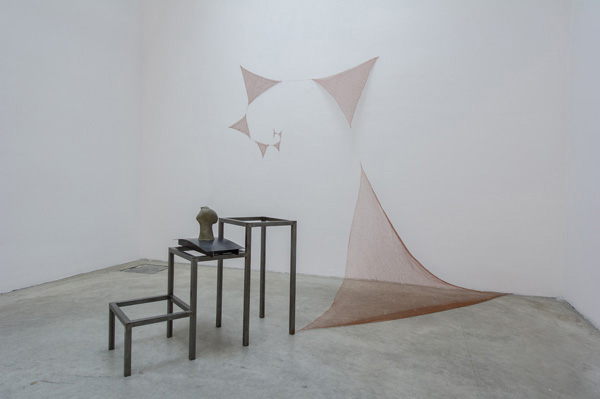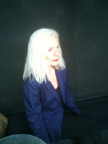|

MARISA MERZ
installation view, Courtesy Fondazione Merz, Photo
Paolo Pellion
Marisa Merz
disegnare
disegnare
ridisegnare
il pensiero immagine che cammina
at Fondazione Merz, Turin
By Floriana Piqué
This is really her exhibition, for Marisa Merz chose the works to be presented and painstakingly
curated their installation, allowing us to reach a new level of understanding. The poem giving title to the
show, Marisa’s own words, is a synthesis of her work and also a suggestion on how to read the entire exhibition at the
Fondazione Merz, a foundation dedicated to the artist Mario Merz, her late husband, opened in 2005.
The
first room, full of signs and anticipations, invites us to discover all the themes, ideas, and techniques that constitute
a continuum in the work of an artist whose career spans more than four decades. Marisa’s choice to show on
this occasion more than one hundred works in an installation conceived uniquely for this space and in an atemporal sequence
imaginatively transforms the perception of each single painting or sculpture.
There
is no passing of time; traces need to be found amongst almost invisible hints, for here every detail is equally important.
Merz has punctuated the path with harmonies in counterpoint, resulting in a play of contrasts.

In 1966, in
her studio in Turin, she started exhibiting enigmatic sculptures made from thin sheets of shining aluminium, hanging from
the ceiling or seeping through the wall to interact with the space, forming spirals, simulacra of imagined living creatures. One year later, in 1967, they were part of her first solo show
at the Sperone Gallery in Turin. One of these Living
Sculptures constitutes the main work in the Room dedicated to Marisa Merz at Tate Modern in London. A quotation of this work appears now at the Fondazione Merz in Untitled, 2012,
where a cut from a spiral is the upper frame of a composition of objects and mixed media on a panel on the reverse of a wooden
table. An independent figure of the Arte Povera
movement of late ‘60s, the only woman in the group, in 1968 she took part in the group show Arte Povera + Azioni
Povere , curated by Germano Celant at the Arsenale of Amalfi, together with her husband and companion of a long life,
the late Mario Merz. Since the beginning of the ‘70s
and up until recently, Marisa Merz agreed to show her work only in a particular way, as if the reluctance to participate balanced
the intensity and highlighted the rarity of her presence.

MARISA MERZ installation view, Courtesy Fondazione Merz, Photo Paolo Pellion
Objects of domesticity, of every day use, combined with the unusual manipulation
of materials such as wax, copper wire, clay, wood, fabrics, give life to metaphorical new objects of artistic, universal meaning. These can materialize as sculptures or complex installations that Marisa reworks time
and again: Untitled (no date), a small chair of painted wood with copper wires, Scarpette (Little Shoe),
1968, a shoe knitted in nylon thread which will appear also in copper, probably the size of Marisa’s foot, or Altalena
per Bea (The Swing for Bea), 1968, a swing made of wood and steel for her daughter Beatrice.
The spectator is challenged,
involved at every step to retrace in these works the essence of a woman artist, the profound sense, the constant research,
the singular path that, eluding categorization, in a certain way distinguishes Marisa Merz from other women artists her contemporaries.
On the other hand, her
artistic vision relives and finds numerous points of dialogue in the works of today’s generation of women artists.

MARISA MERZ installation view, Courtesy Fondazione Merz, Photo Paolo Pellion
The
relationship between Marisa and Mario is much more than just an interaction between two strong, independent personalities.
Since life and art always intertwined for Marisa, she’s been at times a protective or a demanding creature. Along her
career, on several occasions Marisa has underlined and enriched the ongoing relationship with a single, specific work that
interacted with Mario Merz’s installations: a silent, intimate, emotional presence.
Now
at the Fondazione she wanted to follow through this habit in a space defined by a large glass and iron table with green apples
by Mario Merz – the iconic spiral shape of his work. She combines a site-specific installation of several small heads,
some in unfired clay, others covered in gold leaf. Scattered below the table and above the table are musical instruments,
violins of wax and gauze and a crystal ball. The final work is unique; even
though the interventions of each artist remain recognizable, the result is something amazingly new. It shows Marisa’s
will to continually renew the dialogue.
Heads sculpted and re-sculpted, drawings drawn and re-drawn unveil in their perpetual becoming a barely identifiable
female figure, a hint of autobiographical identity. The undefined features of these figures
embrace the enigma.
Heads in crude clay, barely modelled, are at times graced with pigments, gold
leaf or are mounted in high, slim tripods facing drawings, vague portraits of feminine features. Gazing up at the sky, these effaced, sightless eyes find a way of whispering, of creating a dialogue
of complicity. Here we can explore how this dynamic has played
in shifting endlessly between autobiography and anonymity.
In the last few years, the features in the drawings became more recognizable: one can
be brought to perceive eyes, mouths…the emotions, quite frozen before, longing now to surface. The present exhibition at the Fondazione has a history in the project Marisa Merz started
in 2006 with the Fondazione Querini Stampalia in Venice, culminated in the exhibition non corrisponde eppur fiorisce
(it doesn’t match yet it flourishes), 2011. In Venice,
a set of new drawings – graphite on canvas, pencil on paper, pastel on wood often enriched with fragments of different
materials – interacts with the Old Masters of the Querini’s collection.
In Turin, a group of Marisa's most recent drawings,
Untitled, 2011-12, 9 panels, mixed media on wood in a Plexiglas box, Untitled, 2011-12, 6 panels, mixed media
on wood and Untitled, 2012, a wood panel, mixed media on paper, clearly indicate a shift towards more identifiable
features while they strengthen the guessing of a self-portrait.
Marisa Merz participated in several editions of the Venice Biennale and in
2001 she was awarded the Venice Biennale Prize for her career. Amongst the most recent solo shows in museums we mention Centre
Georges Pompidou, Paris, 1994; Stedelijk Museum, Amsterdam, 1996; Villa delle Rose, Galleria d’Arte Moderna, Bologna,
1998; Kunstmuseum Winterthur, 2003; MADRE Museum, Naples, 2007; Centre International d’Art et du Paysage, Ile de Vassiviere,
France, 2010.
In Turin, on the floor or hanging off the wall like sails as in Untitled (no date), four triangles
in copper wire, or in more complex installations as in Untitled (Spiral), 1993, or geometrical shapes knitted in copper
wire on the walls highlight a project of work, a consistent corpus that has always been with the artist, present and
renewed since the late ‘60s. The combination of materials
linked to the Arte Povera production with a technique usually associated with women’s artcraft recreates unique sculptures,
Marisa’s unique way of defining space.
And it is in this very exhibition that we can add a new value to her poetics. Having been
always free from the constraints of ideologies and indifferent to the interferences of contingency, Marisa Merz has been able
to create works that encompass the signs of time. Her remarkable
approach to art, how she treats materials, deals with techniques, is silently but strongly present in her installations, all
these elements communicate a way of producing art which is very close to the sensibility of the artists of our day.

Floriana Piqué
is an art critic and independent curator. She
lives and works in London.
Marisa
Merz: disegnare disegnare ridisegnare il pensiero imagine che cammina, Fondazione Merz, Turin, to January 6, 2013.
|
